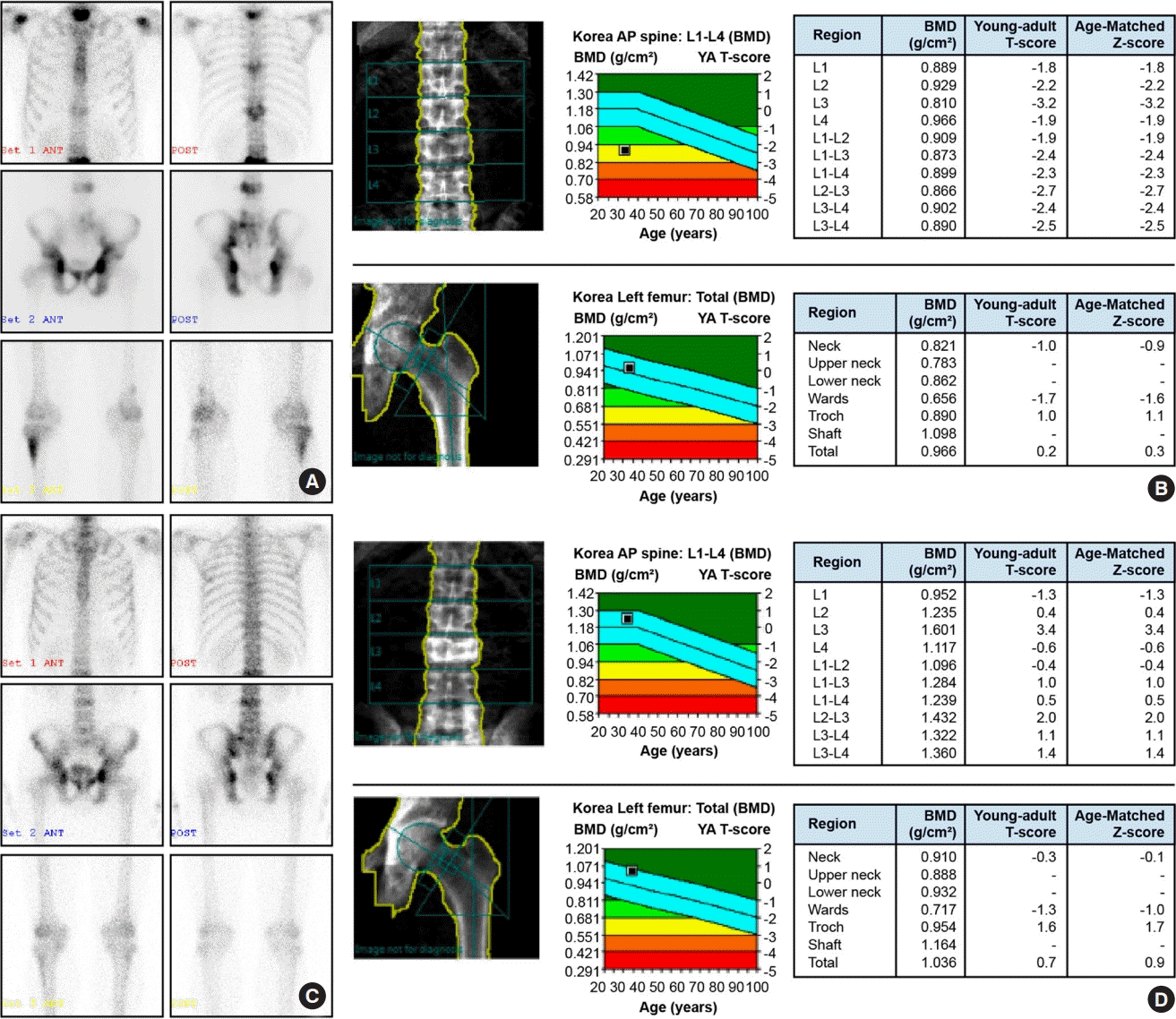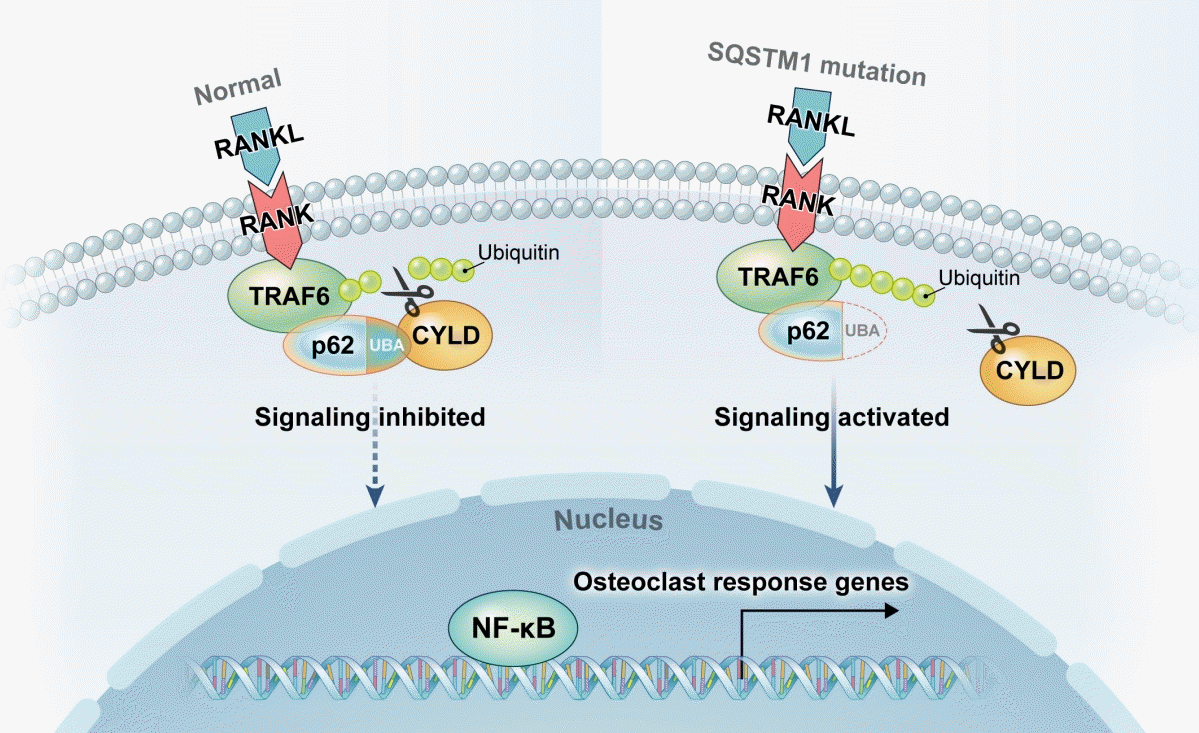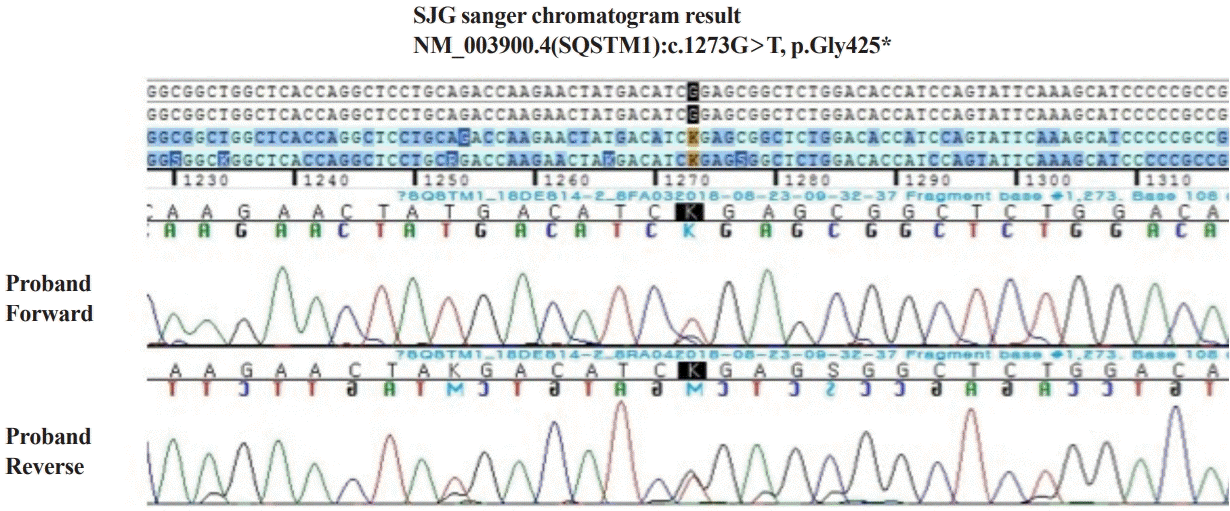1. Gennari L, Rendina D, Falchetti A, Merlotti D. Paget’s disease of bone. Calcif Tissue Int. 2019; 104:483–500.

2. Coppes-Zantinga AR, Coppes MJ. Sir James Paget (1814-1889): a great academic Victorian. J Am Coll Surg. 2000; 191:70–4.

3. Singer FR. Paget’s disease of bone-genetic and environmental factors. Nat Rev Endocrinol. 2015; 11:662–71.

4. Whyte MP. Clinical practice. Paget’s disease of bone. N Engl J Med. 2006; 355:593–600.
5. Kang H, Park YC, Yang KH. Paget’s disease: skeletal manifestations and effect of bisphosphonates. J Bone Metab. 2017; 24:97–103.

6. Vallet M, Ralston SH. Biology and treatment of Paget’s disease of bone. J Cell Biochem. 2016; 117:289–99.

7. Mays S. Archaeological skeletons support a northwest European origin for Paget’s disease of bone. J Bone Miner Res. 2010; 25:1839–41.

8. Sankaran S, Naot D, Grey A, Cundy T. Paget’s disease in patients of Asian descent in New Zealand. J Bone Miner Res. 2012; 27:223–6.

9. Chung YG, Kang YK, Rhee SK, Lee AH, Song SW, Park WJ, et al. Skeletal manifestation of Paget’s disease in Korean. J Korean Orthop Assoc. 2002; 37:649–53.

10. Hashimoto J, Ohno I, Nakatsuka K, Yoshimura N, Takata S, Zamma M, et al. Prevalence and clinical features of Paget’s disease of bone in Japan. J Bone Miner Metab. 2006; 24:186–90.

11. Lee JK, Kang YK, Wang PW, Hong SM. Paget’s disease of bone affecting peripheral limb: difficulties in diagnosis: a case report. J Bone Metab. 2020; 27:71–5.

12. van Staa TP, Selby P, Leufkens HG, Lyles K, Sprafka JM, Cooper C. Incidence and natural history of Paget’s disease of bone in England and Wales. J Bone Miner Res. 2002; 17:465–71.

13. Poor G, Donath J, Fornet B, Cooper C. Epidemiology of Paget’s disease in Europe: the prevalence is decreasing. J Bone Miner Res. 2006; 21:1545–9.

14. Michou L, Orcel P. Has Paget’s bone disease become rare? Joint Bone Spine. 2019; 86:538–41.

15. Tan A, Ralston SH. Clinical presentation of Paget’s disease: evaluation of a contemporary cohort and systematic review. Calcif Tissue Int. 2014; 95:385–92.

16. Reid IR, Nicholson GC, Weinstein RS, Hosking DJ, Cundy T, Kotowicz MA, et al. Biochemical and radiologic improvement in Paget’s disease of bone treated with alendronate: a randomized, placebo-controlled trial. Am J Med. 1996; 101:341–8.

17. Langston AL, Campbell MK, Fraser WD, MacLennan GS, Selby PL, Ralston SH, et al. Randomized trial of intensive bisphosphonate treatment versus symptomatic management in Paget’s disease of bone. J Bone Miner Res. 2010; 25:20–31.

18. Douglas DL, Duckworth T, Kanis JA, Jefferson AA, Martin TJ, Russell RG. Spinal cord dysfunction in Paget’s disease of bone: has medical treatment a vascular basis? J Bone Joint Surg Br. 1981; 63B:495–503.

19. Paul Tuck S, Layfield R, Walker J, Mekkayil B, Francis R. Adult Paget’s disease of bone: a review. Rheumatology (Oxford). 2017; 56:2050–9.

20. Divisato G, Formicola D, Esposito T, Merlotti D, Pazzaglia L, Del Fattore A, et al. ZNF687 mutations in severe Paget disease of bone associated with giant cell tumor. Am J Hum Genet. 2016; 98:275–86.

21. Al-Rashid M, Ramkumar DB, Raskin K, Schwab J, Hornicek FJ, Lozano-Calderon SA. Paget disease of bone. Orthop Clin North Am. 2015; 46:577–85.

22. Reid IR, Davidson JS, Wattie D, Wu F, Lucas J, Gamble GD, et al. Comparative responses of bone turnover markers to bisphosphonate therapy in Paget’s disease of bone. Bone. 2004; 35:224–30.

23. Whitehouse RW. Paget’s disease of bone. Semin Musculoskelet Radiol. 2002; 6:313–22.

24. Lopez C, Thomas DV, Davies AM. Neoplastic transformation and tumour-like lesions in Paget’s disease of bone: a pictorial review. Eur Radiol. 2003; 13 Suppl 4:L151–63.

25. Shirazi PH, Ryan WG, Fordham EW. Bone scanning in evaluation of Paget’s disease of bone. CRC Crit Rev Clin Radiol Nucl Med. 1974; 5:523–58.
26. Fogelman I, Carr D. A comparison of bone scanning and radiology in the assessment of patients with symptomatic Paget’s disease. Eur J Nucl Med. 1980; 5:417–21.

27. Kanis JA. Pathophysiology and treatment of Paget’s disease of bone. 2nd ed. London: Martin Dunitz;1991. p. 1–293.
28. Menaa C, Barsony J, Reddy SV, Cornish J, Cundy T, Roodman GD. 1,25-Dihydroxyvitamin D3 hypersensitivity of osteoclast precursors from patients with Paget’s disease. J Bone Miner Res. 2000; 15:228–36.

29. Neale SD, Smith R, Wass JA, Athanasou NA. Osteoclast differentiation from circulating mononuclear precursors in Paget’s disease is hypersensitive to 1,25-dihydroxyvitamin D(3) and RANKL. Bone. 2000; 27:409–16.

30. Menaa C, Reddy SV, Kurihara N, Maeda H, Anderson D, Cundy T, et al. Enhanced RANK ligand expression and responsivity of bone marrow cells in Paget’s disease of bone. J Clin Invest. 2000; 105:1833–8.

31. Kurihara N, Reddy SV, Araki N, Ishizuka S, Ozono K, Cornish J, et al. Role of TAFII-17, a VDR binding protein, in the increased osteoclast formation in Paget’s disease. J Bone Miner Res. 2004; 19:1154–64.

32. Nagy ZB, Gergely P, Donath J, Borgulya G, Csanad M, Poor G. Gene expression profiling in Paget’s disease of bone: upregulation of interferon signaling pathways in pagetic monocytes and lymphocytes. J Bone Miner Res. 2008; 23:253–9.

33. Morales-Piga AA, Rey-Rey JS, Corres-Gonzalez J, Garcia-Sagredo JM, Lopez-Abente G. Frequency and characteristics of familial aggregation of Paget’s disease of bone. J Bone Miner Res. 1995; 10:663–70.

34. Morissette J, Laurin N, Brown JP. Sequestosome 1: mutation frequencies, haplotypes, and phenotypes in familial Paget’s disease of bone. J Bone Miner Res. 2006; 21 Suppl 2:P38–44.

35. Eekhoff EW, Karperien M, Houtsma D, Zwinderman AH, Dragoiescu C, Kneppers AL, et al. Familial Paget’s disease in the Netherlands: occurrence, identification of new mutations in the sequestosome 1 gene, and their clinical associations. Arthritis Rheum. 2004; 50:1650–4.

36. Siris ES, Ottman R, Flaster E, Kelsey JL. Familial aggregation of Paget’s disease of bone. J Bone Miner Res. 1991; 6:495–500.

37. Sofaer JA, Holloway SM, Emery AE. A family study of Paget’s disease of bone. J Epidemiol Community Health. 1983; 37:226–31.

38. Hocking LJ, Herbert CA, Nicholls RK, Williams F, Bennett ST, Cundy T, et al. Genomewide search in familial Paget disease of bone shows evidence of genetic heterogeneity with candidate loci on chromosomes 2q36, 10p13, and 5q35. Am J Hum Genet. 2001; 69:1055–61.

39. Laurin N, Brown JP, Lemainque A, Duchesne A, Huot D, Lacourciere Y, et al. Paget disease of bone: mapping of two loci at 5q35-qter and 5q31. Am J Hum Genet. 2001; 69:528–43.

40. Albagha OM, Wani SE, Visconti MR, Alonso N, Goodman K, Brandi ML, et al. Genome-wide association identifies three new susceptibility loci for Paget’s disease of bone. Nat Genet. 2011; 43:685–9.

41. Albagha OM, Visconti MR, Alonso N, Langston AL, Cundy T, Dargie R, et al. Genome-wide association study identifies variants at CSF1, OPTN and TNFRSF11A as genetic risk factors for Paget’s disease of bone. Nat Genet. 2010; 42:520–4.

42. Lucas GJ, Riches PL, Hocking LJ, Cundy T, Nicholson GC, Walsh JP, et al. Identification of a major locus for Paget’s disease on chromosome 10p13 in families of British descent. J Bone Miner Res. 2008; 23:58–63.

43. Laurin N, Brown JP, Morissette J, Raymond V. Recurrent mutation of the gene encoding sequestosome 1 (SQSTM1/p62) in Paget disease of bone. Am J Hum Genet. 2002; 70:1582–8.

44. Hocking LJ, Lucas GJ, Daroszewska A, Mangion J, Olavesen M, Cundy T, et al. Domain-specific mutations in sequestosome 1 (SQSTM1) cause familial and sporadic Paget’s disease. Hum Mol Genet. 2002; 11:2735–9.

45. Hocking LJ, Lucas GJ, Daroszewska A, Cundy T, Nicholson GC, Donath J, et al. Novel UBA domain mutations of SQSTM1 in Paget’s disease of bone: genotype phenotype correlation, functional analysis, and structural consequences. J Bone Miner Res. 2004; 19:1122–7.

46. Cundy T, Naot D, Bava U, Musson D, Tong PC, Bolland M. Familial Paget disease and SQSTM1 mutations in New Zealand. Calcif Tissue Int. 2011; 89:258–64.

47. Alonso N, Calero-Paniagua I, Del Pino-Montes J. Clinical and genetic advances in Paget’s disease of bone: a review. Clin Rev Bone Miner Metab. 2017; 15:37–48.

48. Gennari L, Gianfrancesco F, Di Stefano M, Rendina D, Merlotti D, Esposito T, et al. SQSTM1 gene analysis and gene-environment interaction in Paget’s disease of bone. J Bone Miner Res. 2010; 25:1375–84.

49. Layfield R, Hocking LJ. SQSTM1 and Paget’s disease of bone. Calcif Tissue Int. 2004; 75:347–57.

50. Pankiv S, Clausen TH, Lamark T, Brech A, Bruun JA, Outzen H, et al. p62/SQSTM1 binds directly to Atg8/LC3 to facilitate degradation of ubiquitinated protein aggregates by autophagy. J Biol Chem. 2007; 282:24131–45.

51. Cecchini MG, Hofstetter W, Halasy J, Wetterwald A, Felix R. Role of CSF-1 in bone and bone marrow development. Mol Reprod Dev. 1997; 46:75–83.

52. Kajiho H, Saito K, Tsujita K, Kontani K, Araki Y, Kurosu H, et al. RIN3: a novel Rab5 GEF interacting with amphiphysin II involved in the early endocytic pathway. J Cell Sci. 2003; 116(Pt 20):4159–68.

53. Kukita T, Wada N, Kukita A, Kakimoto T, Sandra F, Toh K, et al. RANKL-induced DC-STAMP is essential for osteoclastogenesis. J Exp Med. 2004; 200:941–6.

54. Friedrichs WE, Reddy SV, Bruder JM, Cundy T, Cornish J, Singer FR, et al. Sequence analysis of measles virus nucleocapsid transcripts in patients with Paget’s disease. J Bone Miner Res. 2002; 17:145–51.

55. Mee AP, Dixon JA, Hoyland JA, Davies M, Selby PL, Mawer EB. Detection of canine distemper virus in 100% of Paget’s disease samples by in situ-reverse transcriptase-polymerase chain reaction. Bone. 1998; 23:171–5.

56. Matthews BG, Afzal MA, Minor PD, Bava U, Callon KE, Pitto RP, et al. Failure to detect measles virus ribonucleic acid in bone cells from patients with Paget’s disease. J Clin Endocrinol Metab. 2008; 93:1398–401.

57. Ralston SH, Afzal MA, Helfrich MH, Fraser WD, Gallagher JA, Mee A, et al. Multicenter blinded analysis of RT-PCR detection methods for paramyxoviruses in relation to Paget’s disease of bone. J Bone Miner Res. 2007; 22:569–77.

58. Barker DJ, Gardner MJ. Distribution of Paget’s disease in England, Wales and Scotland and a possible relationship with vitamin D deficiency in childhood. Br J Prev Soc Med. 1974; 28:226–32.

59. Barry HC. Paget’s disease of bone. Edinburgh: Churchill Livingstone;1969. p. 1–196.

60. Solomon LR. Billiard-player’s fingers: an unusual case of Paget’s disease of bone. Br Med J. 1979; 1:931.

61. Smith SE, Murphey MD, Motamedi K, Mulligan ME, Resnik CS, Gannon FH. From the archives of the AFIP: radiologic spectrum of Paget disease of bone and its complications with pathologic correlation. Radiographics. 2002; 22:1191–216.
62. Winn N, Lalam R, Cassar-Pullicino V. Imaging of Paget’s disease of bone. Wien Med Wochenschr. 2017; 167:9–17.

63. Theodorou DJ, Theodorou SJ, Kakitsubata Y. Imaging of Paget disease of bone and its musculoskeletal complications: review. AJR Am J Roentgenol. 2011; 196(6 Suppl):S64–75.
64. Eekhoff ME, Zwinderman AH, Haverkort DM, Cremers SC, Hamdy NA, Papapoulos SE. Determinants of induction and duration of remission of Paget’s disease of bone after bisphosphonate (olpadronate) therapy. Bone. 2003; 33:831–8.

65. Ralston SH, Langston AL, Reid IR. Pathogenesis and management of Paget’s disease of bone. Lancet. 2008; 372:155–63.

66. Shankar S, Hosking DJ. Biochemical assessment of Paget’s disease of bone. J Bone Miner Res. 2006; 21 Suppl 2:P22–7.

67. Albagha OM, Visconti MR, Alonso N, Wani S, Goodman K, Fraser WD, et al. Common susceptibility alleles and SQSTM1 mutations predict disease extent and severity in a multinational study of patients with Paget’s disease. J Bone Miner Res. 2013; 28:2338–46.

68. Cronin O, Forsyth L, Goodman K, Lewis SC, Keerie C, Walker A, et al. Zoledronate in the prevention of Paget’s (ZiPP): protocol for a randomised trial of genetic testing and targeted zoledronic acid therapy to prevent SQSTM1-mediated Paget’s disease of bone. BMJ Open. 2019; 9:e030689.
69. Cronin O, Subedi D, Forsyth L, Goodman K, Lewis SC, Keerie C, et al. Characteristics of early Paget’s disease in SQSTM1 mutation carriers: baseline analysis of the ZiPP study cohort. J Bone Miner Res. 2020; 35:1246–52.
70. Guay-Belanger S, Simonyan D, Bureau A, Gagnon E, Albert C, Morissette J, et al. Development of a molecular test of Paget’s disease of bone. Bone. 2016; 84:213–21.

71. Reid IR, Miller P, Lyles K, Fraser W, Brown JP, Saidi Y, et al. Comparison of a single infusion of zoledronic acid with risedronate for Paget’s disease. N Engl J Med. 2005; 353:898–908.

72. Dunford JE, Thompson K, Coxon FP, Luckman SP, Hahn FM, Poulter CD, et al. Structure-activity relationships for inhibition of farnesyl diphosphate synthase in vitro and inhibition of bone resorption in vivo by nitrogen-containing bisphosphonates. J Pharmacol Exp Ther. 2001; 296:235–42.
73. Hosking D, Lyles K, Brown JP, Fraser WD, Miller P, Curiel MD, et al. Long-term control of bone turnover in Paget’s disease with zoledronic acid and risedronate. J Bone Miner Res. 2007; 22:142–8.

74. Reid IR, Lyles K, Su G, Brown JP, Walsh JP, del Pino-Montes J, et al. A single infusion of zoledronic acid produces sustained remissions in Paget disease: data to 6.5 years. J Bone Miner Res. 2011; 26:2261–70.

75. Reid IR, Gamble GD, Mesenbrink P, Lakatos P, Black DM. Characterization of and risk factors for the acute-phase response after zoledronic acid. J Clin Endocrinol Metab. 2010; 95:4380–7.

76. Siris ES, Chines AA, Altman RD, Brown JP, Johnston CC Jr, Lang R, et al. Risedronate in the treatment of Paget’s disease of bone: an open label, multicenter study. J Bone Miner Res. 1998; 13:1032–8.

77. Hosking DJ, Eusebio RA, Chines AA. Paget’s disease of bone: reduction of disease activity with oral risedronate. Bone. 1998; 22:51–5.
78. Singer FR, Clemens TL, Eusebio RA, Bekker PJ. Risedronate, a highly effective oral agent in the treatment of patients with severe Paget’s disease. J Clin Endocrinol Metab. 1998; 83:1906–10.

79. Dodd GW, Ibbertson HK, Fraser TR, Holdaway IM, Wattie D. Radiological assessment of Paget’s disease of bone after treatment with the bisphosphonates EHDP and APD. Br J Radiol. 1987; 60:849–60.

80. Siris E, Weinstein RS, Altman R, Conte JM, Favus M, Lombardi A, et al. Comparative study of alendronate versus etidronate for the treatment of Paget’s disease of bone. J Clin Endocrinol Metab. 1996; 81:961–7.

81. Frijlink WB, Bijvoet OL, te Velde J, Heynen G. Treatment of Paget’s disease with (3-amino-1-hydroxypropylidene)-1, 1-bisphosphonate (A.P.D.). Lancet. 1979; 1:799–803.

82. Reid IR, Sharma S, Kalluru R, Eagleton C. Treatment of Paget’s disease of bone with denosumab: case report and literature review. Calcif Tissue Int. 2016; 99:322–5.

83. Polyzos SA, Singhellakis PN, Naot D, Adamidou F, Malandrinou FC, Anastasilakis AD, et al. Denosumab treatment for juvenile Paget’s disease: results from two adult patients with osteoprotegerin deficiency (“Balkan” mutation in the TNFRSF11B gene). J Clin Endocrinol Metab. 2014; 99:703–7.
84. Grasemann C, Schundeln MM, Hovel M, Schweiger B, Bergmann C, Herrmann R, et al. Effects of RANK-ligand antibody (denosumab) treatment on bone turnover markers in a girl with juvenile Paget’s disease. J Clin Endocrinol Metab. 2013; 98:3121–6.

85. Nancollas GH, Tang R, Phipps RJ, Henneman Z, Gulde S, Wu W, et al. Novel insights into actions of bisphosphonates on bone: differences in interactions with hydroxyapatite. Bone. 2006; 38:617–27.

86. Wallace E, Wong J, Reid IR. Pamidronate treatment of the neurologic sequelae of pagetic spinal stenosis. Arch Intern Med. 1995; 155:1813–5.

87. Patel S, Stone MD, Coupland C, Hosking DJ. Determinants of remission of Paget’s disease of bone. J Bone Miner Res. 1993; 8:1467–73.

88. Singer FR, Bone HG 3rd, Hosking DJ, Lyles KW, Murad MH, Reid IR, et al. Paget’s disease of bone: an endocrine society clinical practice guideline. J Clin Endocrinol Metab. 2014; 99:4408–22.







 PDF
PDF Citation
Citation Print
Print




 XML Download
XML Download